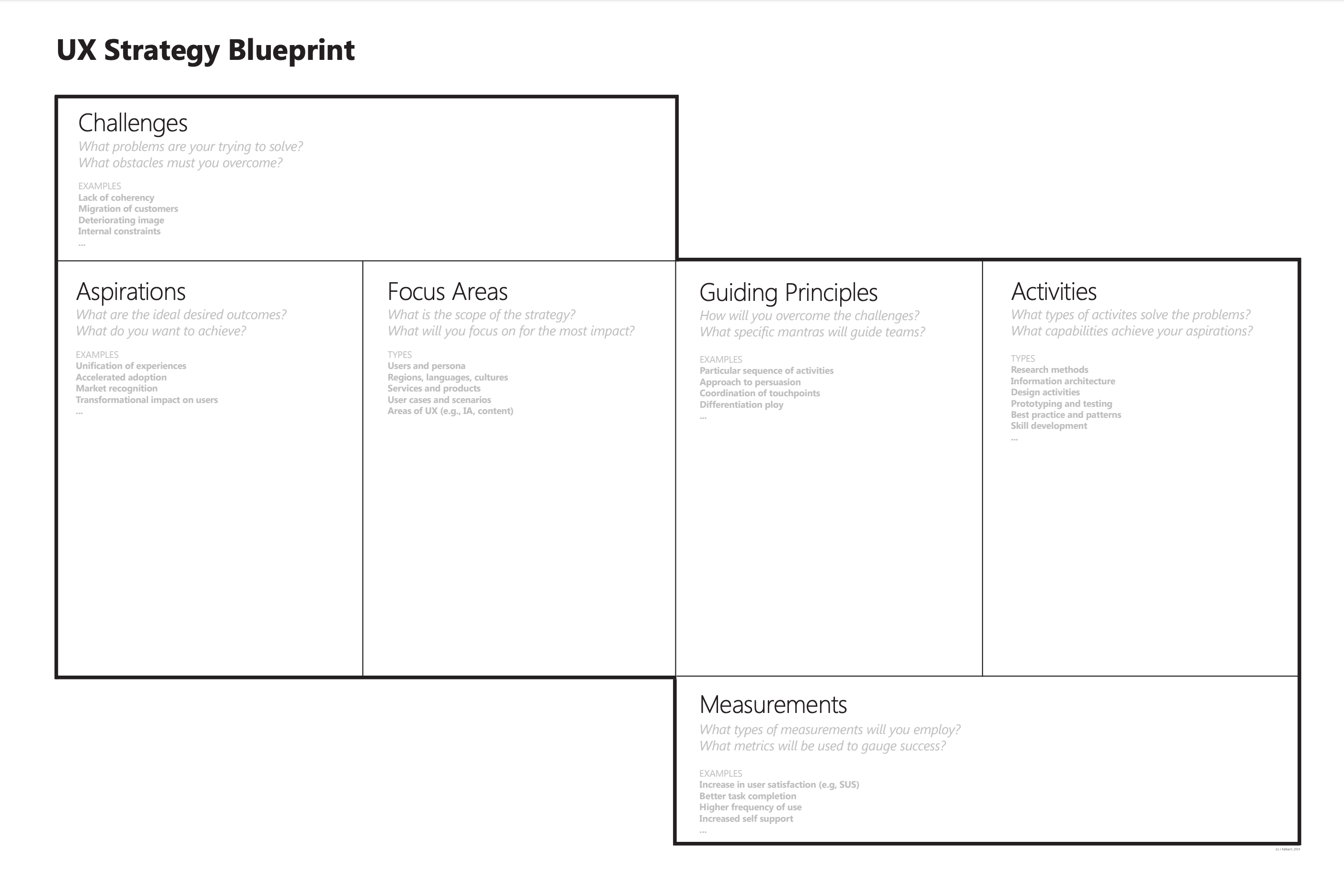UX Strategy
TL;DR
A UX Strategy is a plan that supports the overall Business Strategy. It focuses on delivering an intended experience to a specific target group. The strategy includes a goal, steps to reach it, and ways to measure progress. It can also include key roles or tools needed, milestones, and expected challenges. It should be short.
What is a UX Strategy
A strategy is just a high-level plan with a few key elements. It's intended to communicate key aspects of a project and to help them focus on what's important to make it happen. It is not a detailed, highly researched document.
The document can take pretty much any form but as a rule of thumb, it should fit on a single A4 page and that should have plenty of whitespaces. A popular form the UX Strategy Blueprint.
 Source: UX Strategy Blueprint
Source: UX Strategy Blueprint
I prefer a simpler form. I focus on:
Goals
What do I want to achieve? Since this a UX strategy that focus should be on the experience, that is, on what emotion(s) we want to achieve. This should include a very brief description of the target audience. A good way to think of it is by providing the answer to two questions: "Who are we doing it for?" and "Why should they care?"
Scope of Work
A brief statement of where we are now and the key steps needed to get to the goal.
Metrics
There are two classes of metrics needed:
-
Progress: Checking off milestones, verifying that we're within budget, etc.
-
Goal Value: Verifying that our goal is still worth reaching. We'll probably do this less often, monthly at most maybe quarterly. It may include updating the competitive landscape, verifying tools underlying our goal are still appropriate, etc.
Some optional elements may be 'anticipated challenges', budget forecasts and 'roles needed' to reach the goal.
The form of the strategy document is less important than how it helps you to design an experience. It's vital that all stakeholders understand the entire thing and that the authors believe it. Otherwise, it's just empty marketing.
Why You Might Want a UX Strategy
Writing a strategy forces the key stakeholders to think about what is vital to the project, in this case about the experiential aspects of it and the key steps to making it happen. It also effectively communicates the vision and plans to the rest of the team so they can better play their parts.
Problems the UX Strategy Solves
- Lack of vision or purpose of individual efforts
- Demotivated team
- Meaningless work
- Constantly shifting goals
- Not feeling progress
How to Implement a UX Strategy
A strategy is a thing of vision, not detail. It needs to be developed by a team with sufficient political mandate and budgetary power to be able to make it happen, technical understanding to realistically foresee challenges, and small enough to reach a strong consensus in a reasonable timeframe.
They need to:
-
Agree on and believe in the vision.
-
Formulate a statement of the goal that is short, clear, grand and if at all possible, inspiring. Musk's goal, "I want to die in a city on Mars" is perfect.
-
Understand the challenges to reaching the goal and outline the top-level steps needed to get there. This is not a generic list, it's one that describes what your team needs to do.
-
Define metrics that will measure what really needs to be measured. Don't count clicks if sales are what's important.
-
Devise a plan to periodically review and update the strategy.
-
Decide on how to communicate the strategy most effectively (to get maximum buy-in and enthusiasm from the team) and choose a form that will achieve it.
Common Pitfalls to a UX Strategy
-
Misunderstanding of 'experience' and why it's important to this project.
-
Lack of belief by the leadership team. If they don't understand or just see the strategy as a task that needs to be checked off it probably won't have much effect on the rest of the team.
-
Too much detail. Everyone who needs to work with the strategy needs to understand all of it and be guided, even inspired by it. Those implementing the strategy are the field experts, they will fill in details.
-
Not enough specifics. It is a plan for you and your team - not a list of best practices for anyone. The leaders writing the strategy and the team assembled to implement it has particular talents and qualities and motivations that make them appropriate for the task. Those qualities need to be reflected in the strategy.
Resources for the UX Strategy
Want to write for DXKB?
Feel free to contribute. People from DXKB community will be more than happy.
Related articles
ALL ARTICLES
UX Testing: Goals
UX Testing needs to focus on gaining specific and actionable information that will help the team make better-informed decisions that will, in turn, push the project toward fulfilling the overall UX Strategy. Setting clear goals will help achieve that.
Read moreUX Prototyping
A prototype is a model of a system (in our case an app, web, business process, or UI) built to test elements of the intended system. It is not primarily a final design candidate or MVP.
Read moreJobs To Be Done
Jobs To Be Done (JTBD) is a theory for understanding the process of consumer life’s transformation. The usage of JTBD improves your product design.
Read moreALL ARTICLES